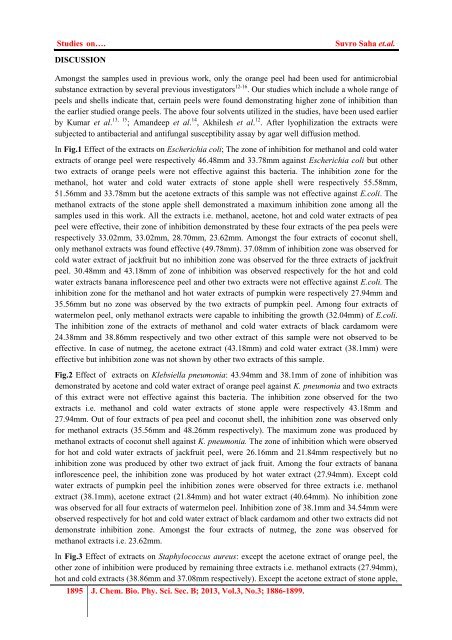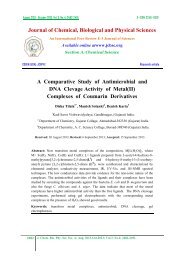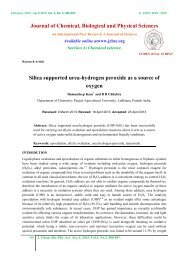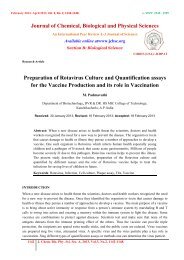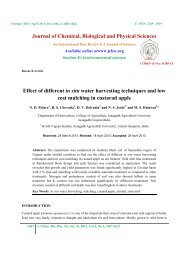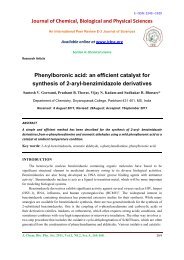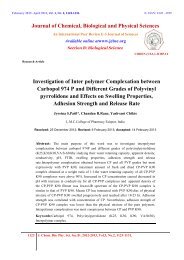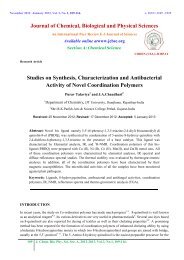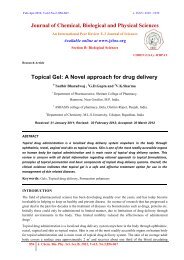<str<strong>on</strong>g>Studies</str<strong>on</strong>g> <strong>on</strong>….Suvro Saha et.al.DISCUSSIONAm<strong>on</strong>gst the samples used in previous work, <strong>on</strong>ly the orange peel had been used for antimicrobialsubstance extracti<strong>on</strong> by several previous investigators 12-16 . Our studies which include a whole range <strong>of</strong>peels and shells indicate that, certain peels were found dem<strong>on</strong>strating higher z<strong>on</strong>e <strong>of</strong> inhibiti<strong>on</strong> thanthe earlier studied orange peels. The above four solvents utilized in the studies, have been used earlierby Kumar et al. 13, 15 ; Amandeep et al. 14 , Akhilesh et al. 12 . After lyophilizati<strong>on</strong> the extracts weresubjected to antibacterial and antifungal susceptibility assay by agar well diffusi<strong>on</strong> method.In Fig.1 Effect <strong>of</strong> the extracts <strong>on</strong> Escherichia coli; The z<strong>on</strong>e <strong>of</strong> inhibiti<strong>on</strong> for methanol and cold waterextracts <strong>of</strong> orange peel were respectively 46.48mm and 33.78mm against Escherichia coli but othertwo extracts <strong>of</strong> orange peels were not effective against this bacteria. The inhibiti<strong>on</strong> z<strong>on</strong>e for themethanol, hot water and cold water extracts <strong>of</strong> st<strong>on</strong>e apple shell were respectively 55.58mm,51.56mm and 33.78mm but the acet<strong>on</strong>e extracts <strong>of</strong> this sample was not effective against E.coli. Themethanol extracts <strong>of</strong> the st<strong>on</strong>e apple shell dem<strong>on</strong>strated a maximum inhibiti<strong>on</strong> z<strong>on</strong>e am<strong>on</strong>g all thesamples used in this work. All the extracts i.e. methanol, acet<strong>on</strong>e, hot and cold water extracts <strong>of</strong> peapeel were effective, their z<strong>on</strong>e <strong>of</strong> inhibiti<strong>on</strong> dem<strong>on</strong>strated by these four extracts <strong>of</strong> the pea peels wererespectively 33.02mm, 33.02mm, 28.70mm, 23.62mm. Am<strong>on</strong>gst the four extracts <strong>of</strong> coc<strong>on</strong>ut shell,<strong>on</strong>ly methanol extracts was found effective (49.78mm). 37.08mm <strong>of</strong> inhibiti<strong>on</strong> z<strong>on</strong>e was observed forcold water extract <strong>of</strong> jackfruit but no inhibiti<strong>on</strong> z<strong>on</strong>e was observed for the three extracts <strong>of</strong> jackfruitpeel. 30.48mm and 43.18mm <strong>of</strong> z<strong>on</strong>e <strong>of</strong> inhibiti<strong>on</strong> was observed respectively for the hot and coldwater extracts banana inflorescence peel and other two extracts were not effective against E.coli. Theinhibiti<strong>on</strong> z<strong>on</strong>e for the methanol and hot water extracts <strong>of</strong> pumpkin were respectively 27.94mm and35.56mm but no z<strong>on</strong>e was observed by the two extracts <strong>of</strong> pumpkin peel. Am<strong>on</strong>g four extracts <strong>of</strong>watermel<strong>on</strong> peel, <strong>on</strong>ly methanol extracts were capable to inhibiting the growth (32.04mm) <strong>of</strong> E.coli.The inhibiti<strong>on</strong> z<strong>on</strong>e <strong>of</strong> the extracts <strong>of</strong> methanol and cold water extracts <strong>of</strong> black cardamom were24.38mm and 38.86mm respectively and two other extract <strong>of</strong> this sample were not observed to beeffective. In case <strong>of</strong> nutmeg, the acet<strong>on</strong>e extract (43.18mm) and cold water extract (38.1mm) wereeffective but inhibiti<strong>on</strong> z<strong>on</strong>e was not shown by other two extracts <strong>of</strong> this sample.Fig.2 Effect <strong>of</strong> extracts <strong>on</strong> Klebsiella pneum<strong>on</strong>ia: 43.94mm and 38.1mm <strong>of</strong> z<strong>on</strong>e <strong>of</strong> inhibiti<strong>on</strong> wasdem<strong>on</strong>strated by acet<strong>on</strong>e and cold water extract <strong>of</strong> orange peel against K. pneum<strong>on</strong>ia and two extracts<strong>of</strong> this extract were not effective against this bacteria. The inhibiti<strong>on</strong> z<strong>on</strong>e observed for the twoextracts i.e. methanol and cold water extracts <strong>of</strong> st<strong>on</strong>e apple were respectively 43.18mm and27.94mm. Out <strong>of</strong> four extracts <strong>of</strong> pea peel and coc<strong>on</strong>ut shell, the inhibiti<strong>on</strong> z<strong>on</strong>e was observed <strong>on</strong>lyfor methanol extracts (35.56mm and 48.26mm respectively). The maximum z<strong>on</strong>e was produced bymethanol extracts <strong>of</strong> coc<strong>on</strong>ut shell against K. pneum<strong>on</strong>ia. The z<strong>on</strong>e <strong>of</strong> inhibiti<strong>on</strong> which were observedfor hot and cold water extracts <strong>of</strong> jackfruit peel, were 26.16mm and 21.84mm respectively but noinhibiti<strong>on</strong> z<strong>on</strong>e was produced by other two extract <strong>of</strong> jack fruit. Am<strong>on</strong>g the four extracts <strong>of</strong> bananainflorescence peel, the inhibiti<strong>on</strong> z<strong>on</strong>e was produced by hot water extract (27.94mm). Except coldwater extracts <strong>of</strong> pumpkin peel the inhibiti<strong>on</strong> z<strong>on</strong>es were observed for three extracts i.e. methanolextract (38.1mm), acet<strong>on</strong>e extract (21.84mm) and hot water extract (40.64mm). No inhibiti<strong>on</strong> z<strong>on</strong>ewas observed for all four extracts <strong>of</strong> watermel<strong>on</strong> peel. Inhibiti<strong>on</strong> z<strong>on</strong>e <strong>of</strong> 38.1mm and 34.54mm wereobserved respectively for hot and cold water extract <strong>of</strong> black cardamom and other two extracts did notdem<strong>on</strong>strate inhibiti<strong>on</strong> z<strong>on</strong>e. Am<strong>on</strong>gst the four extracts <strong>of</strong> nutmeg, the z<strong>on</strong>e was observed formethanol extracts i.e. 23.62mm.In Fig.3 Effect <strong>of</strong> extracts <strong>on</strong> Staphylococcus aureus: except the acet<strong>on</strong>e extract <strong>of</strong> orange peel, theother z<strong>on</strong>e <strong>of</strong> inhibiti<strong>on</strong> were produced by remaining three extracts i.e. methanol extracts (27.94mm),hot and cold extracts (38.86mm and 37.08mm respectively). Except the acet<strong>on</strong>e extract <strong>of</strong> st<strong>on</strong>e apple,1895 J. Chem. Bio. Phy. Sci. Sec. B; 2013, Vol.3, No.3; 1886-1899.
<str<strong>on</strong>g>Studies</str<strong>on</strong>g> <strong>on</strong>….Suvro Saha et.al.the z<strong>on</strong>e <strong>of</strong> inhibiti<strong>on</strong> were 49.78mm, 43.18mm and 35.56mm respectively for methanol whichdem<strong>on</strong>strated a maximum z<strong>on</strong>e, hot and cold water extracts <strong>of</strong> st<strong>on</strong>e apple against S. aureus. N<strong>on</strong>e <strong>of</strong>the four extracts <strong>of</strong> the pea peel produced inhibiti<strong>on</strong> z<strong>on</strong>e. The inhibiti<strong>on</strong> z<strong>on</strong>es were producedrespectively by methanol extracts (47.75mm), acet<strong>on</strong>e extracts (29.46mm) and hot water extracts(20.32mm) <strong>of</strong> coc<strong>on</strong>ut shell but no z<strong>on</strong>e was observed for cold water extract <strong>of</strong> this sample. 30.48mmand 33.78mm <strong>of</strong> inhibiti<strong>on</strong> z<strong>on</strong>e was observed respectively for the acet<strong>on</strong>e and hot water extract <strong>of</strong>jackfruit peel and no z<strong>on</strong>e <strong>of</strong> inhibiti<strong>on</strong> was seen for other two extract <strong>of</strong> this sample. Am<strong>on</strong>g the fourextracts <strong>of</strong> banana inflorescence, the inhibiti<strong>on</strong> z<strong>on</strong>e (32.04mm) was observed <strong>on</strong>ly for hot waterextract <strong>of</strong> this sample against S. aureus. Apart from cold water extract <strong>of</strong> pumpkin peel, the inhibiti<strong>on</strong>z<strong>on</strong>es were observed for methanol extracts (26.16mm), acet<strong>on</strong>e extract (34.54mm) and hot waterextract (38.1mm). Inhibiti<strong>on</strong> z<strong>on</strong>e <strong>of</strong> 33.02mm and 24.38mm were observed respectively for methanoland hot water extract <strong>of</strong> watermel<strong>on</strong> peel but remaining two extracts <strong>of</strong> this sample did not produceany observable z<strong>on</strong>e <strong>of</strong> inhibiti<strong>on</strong>. Am<strong>on</strong>g the four extracts <strong>of</strong> black cardamom, inhibiti<strong>on</strong> z<strong>on</strong>e(36.32mm) was observed <strong>on</strong>ly for methanol extract <strong>of</strong> this sample. Am<strong>on</strong>g the four extracts <strong>of</strong>nutmeg, the z<strong>on</strong>e was <strong>on</strong>ly observed for cold water extracts i.e. 42.16mm.In Fig.4 Effect <strong>of</strong> extracts <strong>on</strong> Bacillus subtilis; the z<strong>on</strong>e <strong>of</strong> inhibiti<strong>on</strong> was observed by all four extractsi.e. methanol extract (40.64mm), acet<strong>on</strong>e extract (30.48mm), hot water extract (26.16mm) and coldwater extract (45.72mm) <strong>of</strong> orange peel. Apart from acet<strong>on</strong>e extract <strong>of</strong> st<strong>on</strong>e apple shell, the z<strong>on</strong>e <strong>of</strong>inhibiti<strong>on</strong> was observed as 48.26mm, 39.62mm and 38.86mm respectively by methanol extract, coldand hot water extract <strong>of</strong> this sample; the highest z<strong>on</strong>e <strong>of</strong> inhibiti<strong>on</strong> was shown by the methanol extract<strong>of</strong> st<strong>on</strong>e apple. Am<strong>on</strong>g the four extracts <strong>of</strong> pea peel, the inhibiti<strong>on</strong> z<strong>on</strong>e (40.64mm) was <strong>on</strong>ly observedfor methanol extract <strong>of</strong> this sample. Out <strong>of</strong> four extracts <strong>of</strong> coc<strong>on</strong>ut shell, <strong>on</strong>ly <strong>on</strong>e extract i.e. acet<strong>on</strong>eextract was effective against B.subtilis; giving a inhibiti<strong>on</strong> z<strong>on</strong>e <strong>of</strong> 21.84mm.Am<strong>on</strong>g the four extracts<strong>of</strong> jackfruit peel, the inhibiti<strong>on</strong> z<strong>on</strong>e (38.1mm) was <strong>on</strong>ly seen for cold water extract <strong>of</strong> this sample.The inhibiti<strong>on</strong> z<strong>on</strong>e <strong>of</strong> 42.16mm and 43.18mm was detected respectively for acet<strong>on</strong>e and cold waterextract <strong>of</strong> banana inflorescence but no z<strong>on</strong>e <strong>of</strong> inhibiti<strong>on</strong> for remaining two extract <strong>of</strong> this sample.Except cold water extracts <strong>of</strong> pumpkin peel, inhibiti<strong>on</strong> z<strong>on</strong>e was observed for rest <strong>of</strong> the three extractsi.e. methanol extract (19.30mm), acet<strong>on</strong>e extract (39.62mm) and hot water extract (38.86mm). Am<strong>on</strong>gthe four extracts <strong>of</strong> watermel<strong>on</strong> peel, the inhibiti<strong>on</strong> z<strong>on</strong>e (33.78mm) was <strong>on</strong>ly seen for hot waterextract <strong>of</strong> this sample. The z<strong>on</strong>e <strong>of</strong> inhibiti<strong>on</strong> <strong>of</strong> 47.24mm and 38.1mm was shown by two extracts i.e.hot and cold water extracts <strong>of</strong> black cardamom out <strong>of</strong> four extract and no z<strong>on</strong>e was detected forremaining two extracts <strong>of</strong> the sample. Am<strong>on</strong>g the four extracts <strong>of</strong> nutmeg shell, the inhibiti<strong>on</strong> z<strong>on</strong>e(27.94mm) was <strong>on</strong>ly seen for methanol extract <strong>of</strong> this sample.Fig.5 Effect <strong>of</strong> extracts <strong>on</strong> Proteus vulgaris; the z<strong>on</strong>e <strong>of</strong> inhibiti<strong>on</strong> <strong>of</strong> 23.62mm and 28.70mm wereobserved respectively for acet<strong>on</strong>e and cold water extract <strong>of</strong> orange peel but the other two extractswere not to be effective against the organism. Except the acet<strong>on</strong>e extract <strong>of</strong> the st<strong>on</strong>e apple shell, theinhibiti<strong>on</strong> z<strong>on</strong>e was observed as 41.40mm, 40.64mm, 36.32mm respectively for the methanol, hot andcold water extract <strong>of</strong> the sample. In case <strong>of</strong> pea peel, the inhibiti<strong>on</strong> z<strong>on</strong>e (38.1mm) was <strong>on</strong>ly detectedfor methanol extract <strong>of</strong> pea peel. Apart from cold water extract <strong>of</strong> coc<strong>on</strong>ut shell remaining threeextracts are effective against P. vulgaris; the z<strong>on</strong>es were observed as 49.02mm, 28.70mm and39.62mm respectively for methanol, acet<strong>on</strong>e and hot water extract <strong>of</strong> the sample. Am<strong>on</strong>g the fourextracts <strong>of</strong> jackfruit peel, the inhibiti<strong>on</strong> z<strong>on</strong>e (84.58mm) was <strong>on</strong>ly observed for cold water extract <strong>of</strong>this sample. The inhibiti<strong>on</strong> z<strong>on</strong>e was not observed for all extracts <strong>of</strong> banana inflorescence and watermel<strong>on</strong> peel against P. vulgaris. In case <strong>of</strong> pumpkin peel, the inhibiti<strong>on</strong> z<strong>on</strong>e (36.32mm) was <strong>on</strong>lydetected for methanol extract <strong>of</strong> pumpkin peel. Except the acet<strong>on</strong>e extract <strong>of</strong> the black cardamompeel, the inhibiti<strong>on</strong> z<strong>on</strong>e was observed as 75.18mm, 35.56mm, 48.26mm respectively for themethanol, hot and cold water extract <strong>of</strong> the sample. The z<strong>on</strong>e <strong>of</strong> inhibiti<strong>on</strong> <strong>of</strong> 40.64mm and 38.1mm1896 J. Chem. Bio. Phy. Sci. Sec. B; 2013, Vol.3, No.3; 1886-1899.


